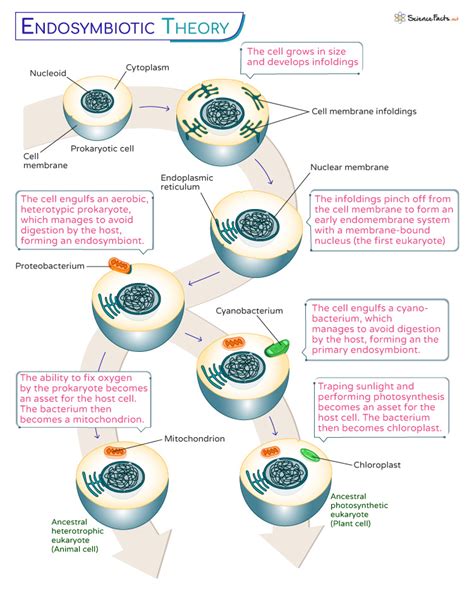The endosymbiotic theory is a widely accepted scientific concept that explains the origin of eukaryotic cells, which are the cells that make up all plants, animals, fungi, and protists. According to the theory, eukaryotic cells evolved from a symbiotic relationship between a primitive prokaryotic cell and various types of bacteria.

The Evidence for Endosymbiosis
There is a wealth of evidence to support the endosymbiotic theory. Some of the most compelling evidence includes:
- The presence of bacteria-like organelles in eukaryotic cells. Eukaryotic cells contain several types of organelles, including mitochondria and chloroplasts, which have their own DNA, ribosomes, and other features that are characteristic of bacteria.
- The similarity of the DNA of organelles to the DNA of free-living bacteria. The DNA of mitochondria and chloroplasts is very similar to the DNA of free-living bacteria, suggesting that they evolved from these bacteria.
- The presence of endosymbiotic bacteria in some modern eukaryotic cells. Some modern eukaryotic cells, such as Paramecium, contain endosymbiotic bacteria that live inside their cytoplasm. These bacteria are essential for the survival of the eukaryotic cell, providing it with nutrients or other essential molecules.
The Evolution of Eukaryotic Cells
The endosymbiotic theory proposes that eukaryotic cells evolved through a series of endosymbiotic events. In the first event, a primitive prokaryotic cell engulfed a bacterium that could respire oxygen. This bacterium eventually became the mitochondrion, an organelle that is responsible for cellular respiration.
In a second event, a photosynthetic bacterium was engulfed by a eukaryotic cell. This bacterium eventually became the chloroplast, an organelle that is responsible for photosynthesis.
Over time, these endosymbiotic bacteria lost their ability to live independently and became essential components of eukaryotic cells.
The Importance of Endosymbiosis
Endosymbiosis has played a major role in the evolution of life on Earth. Without the endosymbiotic origin of mitochondria and chloroplasts, eukaryotic cells would not have been able to evolve.
Mitochondria provide eukaryotic cells with the energy they need to survive. Chloroplasts provide eukaryotic cells with the ability to photosynthesize, which is essential for the production of food.
Applications of the Endosymbiotic Theory
The endosymbiotic theory has a number of applications in modern biology and medicine. For example, the theory has been used to:
- Develop new antibiotics. The endosymbiotic origin of mitochondria and chloroplasts has led to the development of new antibiotics that target these organelles.
- Understand the evolution of new species. The endosymbiotic theory provides a framework for understanding how new species can evolve through the acquisition of new endosymbionts.
- Develop new therapies for diseases. The endosymbiotic origin of mitochondria and chloroplasts has led to the development of new therapies for diseases that are caused by mitochondrial or chloroplast dysfunction.
Conclusion
The endosymbiotic theory is a well-supported scientific concept that has revolutionized our understanding of the evolution of life on Earth. The theory provides a framework for understanding how eukaryotic cells evolved and how new species can emerge. The endosymbiotic theory has also led to a number of practical applications in modern biology and medicine.
